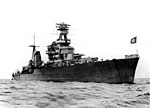Volga–Baltic Waterway
Baltic SeaCanals in RussiaCanals opened in 1964Commons category link is defined as the pagenameGeography of Leningrad Oblast ... and 4 more
Geography of Vologda OblastNeva RiverTransport in Leningrad OblastVolga basin

The Volga–Baltic Waterway (Волгобалт), formerly known as the Mariinsk Canal System (Мариинская водная система), is a series of canals and rivers in Russia which link the Volga with the Baltic Sea via the Neva. Like the Volga–Don Canal, it connects the biggest lake on Earth, the Caspian Sea, to the World Ocean. Its overall length between Cherepovets and Lake Onega is 368 kilometres (229 mi). Originally constructed in the early 19th century, the system was rebuilt for larger vessels in the 1960s, becoming a part of the Unified Deep Water System of European Russia. The original name "Mariinsky" is the credit to Empress Maria Feodorovna, the second wife of Emperor Paul I of Russia.
Excerpt from the Wikipedia article Volga–Baltic Waterway (License: CC BY-SA 3.0, Authors, Images).Volga–Baltic Waterway
Geographical coordinates (GPS) Address Nearby Places Show on map
Geographical coordinates (GPS)
| Latitude | Longitude |
|---|---|
| N 59.966666666667 ° | E 30.166666666667 ° |
Address
Санкт-Петербург
Saint Petersburg, Russia
Open on Google Maps










